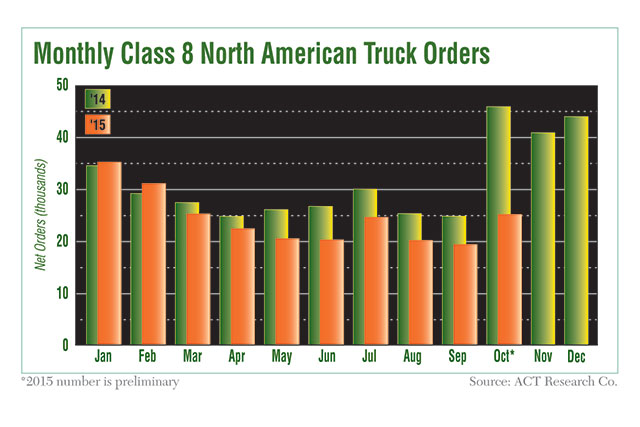Senior Reporter
October Class 8 Orders Down from Historic 2014 Month

New orders in North America for Class 8 trucks dropped sharply in October from the near-record level a year earlier but remained strong compared with traditional order patterns, according to two reports.
ACT Research, in a preliminary report, said Class 8 orders last month totaled 25,200 units, or 45% fewer than the year-earlier total of 45,956, the second-highest level ever reported.
Last month’s total was the fourth-highest of the year and was typical of Class 8 orders in October from 2011 through 2013, which averaged 25,825 units. Orders were also up 30% from 19,421 in September.
The record for orders was set in March 2006, when buyers secured 52,941 trucks in a pre-buy ahead of new emissions standards coming in 2007.
Year-to-date, orders last month totaled 244,100, down about 17% compared with 295,205 in the year-earlier period.
ACT President Kenny Vieth told Transport Topics that he was somewhat surprised by orders in October, which typically marks the start of the strong ordering season for the coming year, but noted there are always many variables in play.
“All it takes is one big order being placed a day sooner or a day later, and you can have substantive differences in any given month’s order. So we try to be less rigid in our expectations of what any month’s orders are going to be,” Vieth said.
However, dealer inventory is a central factor affecting orders, he said.
“The industry over the course of the past 18 to 20 months has put a lot of inventory on the ground. We ended the third quarter at very close to record-level inventory. One of the groups not placing orders into the end of this year would be dealers looking to add stock trucks to their lots,” Vieth said.
He said ACT recently revised its forecast for 2016 production down to 280,000, plus or minus 5,000 units, from 296,000.
Speaking of October’s orders, Vieth said they should not be taken as a sign of the start of a similar major downturn such as the past two or three the industry experienced.
“Those went from robust to horrible over the course of six to nine months. [2016 is] still going to be a pretty darn good year,” he said.
Research firm FTR reported October orders stood slightly lower at 25,000.
Don Ake, FTR’s vice president, called the order level not great but not terrible.
“Fleets are being more cautious this year in their ordering, which is to be expected considering the weak GDP numbers and slower manufacturing growth. If November and December orders are in the same range, then 2016 production should meet expectations,” Ake said.
Truckload carrier Swift Transportation is one fleet taking a pause. Swift ranks No. 6 on the Transport Topics Top 100 list of the largest U.S. and Canadian for-hire carriers.
Swift CEO Jerry Moyes said, in a third-quarter earnings call with analysts last month, “Effective immediately we will enter into a zero fleet growth mode. . . . Until we reach a best-in-class utilization level, we will not be adding any new equipment [beyond normal trade cycles].”
Moyes added Swift may even downsize its fleet to eliminate less profitable accounts.
Thomas Albrecht, an analyst with BB&T Capital Markets, said in a note to investors that Swift will likely finish 2015 with “growth of 500 to 600 units below its original guidance of 700 to 1,100 units.”
“Given our belief that about two-thirds of truckers’ woes are self-inflicted, too much capacity growth in 2015 and one-third are demand-related, especially slumping industrial production, we applaud this move,” he said.




